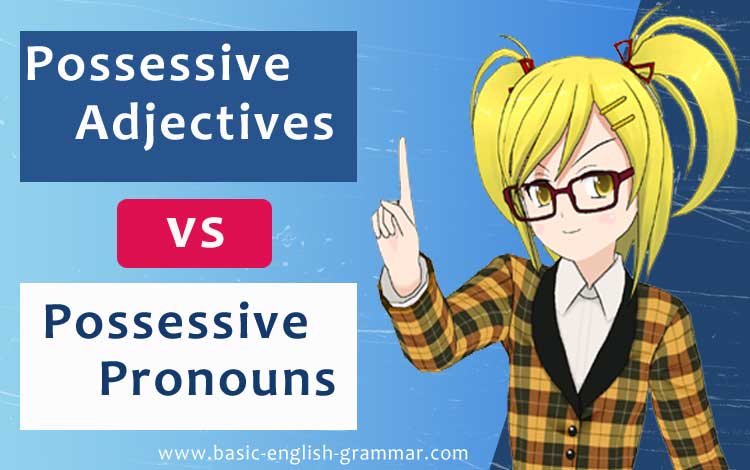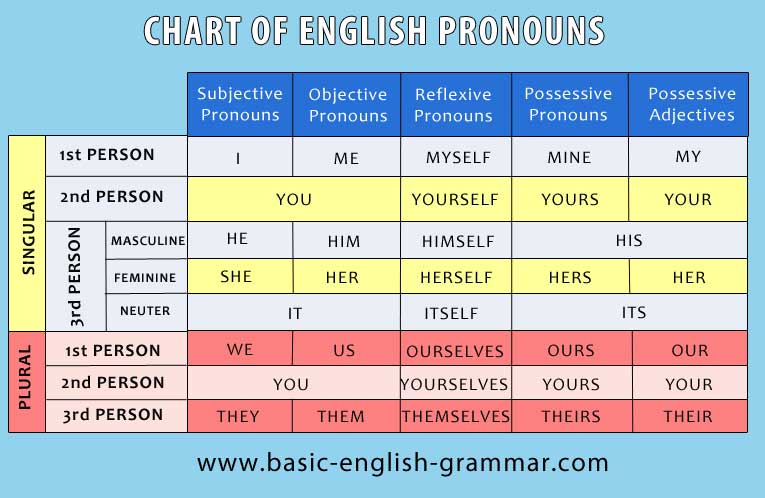The key differences between possessive adjectives and possessive pronouns relate mainly to their grammatical function and position in sentences. Possessive adjectives modify nouns by placing them before nouns; whereas, possessive pronouns stand alone by replacing nouns or noun phrases.
Understanding the difference between possessive adjectives and possessive pronouns is essential for effective communication in English. These small but significant elements play an important role in showing ownership and possession in sentences. As you explore the nuances of possessive adjectives and possessive pronouns, you will be equipped with the knowledge to use them confidently and correctly.

1. What are Possessive Adjectives?
Definition: Possessive adjectives are words that modify nouns in order to show ownership or possession. They are placed before the nouns they describe and they agree with the noun in gender and number.
The 7 possessive adjectives are: my, your, his, her, its, our and theirs. (see chart with the 7 possessive adjectives below)
The best way to understand how possessive adjectives work is to look at some examples.
Examples of the 7 Possessive Adjectives
- That’s my truck parked in the backyard. (The possessive adjective “my” modifies the noun “truck” to show ownership)
- If you pay for your bicycle now, you will get a discount. (The possessive adjective “your” modifies the noun “bicycle” to show ownership)
- David cut down the tree with his chainsaw. (The possessive adjective “his” modifies the noun “chainsaw” to show ownership)
- Jennifer always keeps her room clean and tidy. (The possessive adjective “her” modifies the noun “room” to show ownership)
- The business changed its location when the new owners took over. (The possessive adjective “its” modifies the noun “location” to show ownership)
- We planted vegetables in our garden in order to save money. (The possessive adjective “ours” modifies the noun “garden” to show ownership)
- I drove the children to their homes after the game. (The possessive adjective “their” modifies the noun “homes” to show ownership)
Tips to Use Possessive Adjective Effectively
- Always place possessive adjectives before the nouns they modify.
- Use possessive adjective to show specific ownership of a particular noun.
- Pay attention to the gender and number of the noun when selecting the appropriate possessive adjective.
I have written an in-depth article explaining the function and form of the 7 possessive adjectives. I have also given many examples for a clear understanding of the 7 possessive adjectives.

I have written an article that outlines the 8 Types of Pronouns With Examples. These must-know pronouns will unlock the power of your writing and speaking gifts.
2. What are Possessive Pronouns?
Definition: Possessive pronouns are used to replace nouns or noun phrases (avoiding repetition) in order to show ownership or possession. Possessive pronouns stand alone and do not modify any nouns.
The 7 possessive pronouns are: mine, yours his, hers its, ours and theirs. (see the chart of the 7 possessive pronouns above)
The best way to understand how possessive pronouns work is to look at some examples.
Examples of the 7 Possessive Pronouns
- Did you know that parcel is mine? (The possessive pronoun “mine” replaces the noun “parcel”)
- My camera differs from yours. (The possessive pronoun “yours” replaces the noun “camera”)
- The bicycle is obviously his. (The possessive pronoun “his” replaces the noun “bicycle”)
- Those keys on the table are hers. (The possessive pronoun “hers” replaces the noun “keys”)
- Knowledge has its insights and experience has its. (The possessive pronoun “its” replaces the noun “insights”)
- Which player of ours was injured? (The possessive pronoun “ours” replaces the noun “player”)
- This is my boat. Theirs has been sold recently. (The possessive pronoun “theirs” replaces the noun “boat”)
Tips to Use Possessive Pronouns Effectively
- Use possessive pronouns when you want to replace a noun in order to avoid repetition.
- Possessive pronouns stand alone in sentences without being followed by nouns.
- Make sure to match the possessive pronoun with the correct noun it represents.
I have written an in-depth article explaining the function and form of the 7 possessive pronouns. I have also given many examples for a clear understanding of the 7 possessive pronouns.
3. Possessive Adjectives vs Possessive Pronouns
The key differences between possessive adjectives and possessive pronouns relate mainly to their grammatical function and position in sentences.
Possessive adjectives modify nouns; whereas, possessive pronouns replace nouns and noun phrases.
Here are some examples of possessive adjectives and possessive nouns side by side!
Example #1
- My books are on the table. (possessive adjective)
- Those books on the table are mine. (possessive pronoun)
Summary: The possessive adjective “my” is placed before the noun “books” to modify it in order to show ownership. The possessive pronoun “mine” on the other hand replaces the noun “books” in order to avoid repetition.
Example #2
- Your cat is adorable. (possessive adjective)
- That cat is yours. (possessive pronoun)
Summary: The possessive adjective “your” is placed before the noun “cat” to modify it in order to show ownership. The possessive pronoun “yours” on the other hand replaces the noun “cat” in order to avoid repetition.
Example #3
- Jonathan put his keys on the table. (possessive adjective)
- Those keys on the table are his. (possessive pronoun)
Summary: The possessive adjective “his” is placed before the noun “keys” to modify it in order to show ownership. The possessive pronoun “his” on the other hand replaces the noun “keys” in order to avoid repetition.
Example #4
- Rachel gave her toys to charity. (possessive adjective)
- Those toys given to charity were hers. (possessive pronoun)
Summary: The possessive adjective “her” is placed before the noun “toys” to modify it in order to show ownership. The possessive pronoun “hers” on the other hand replaces the noun “toys” in order to avoid repetition.
Example #5
- Knowledge and experience has its benefits. (possessive adjective)
- Knowledge has its benefits and experience has its. (possessive pronoun)
Summary: The possessive adjective “its” is placed before the noun “benefits” to modify it in order to show ownership. The possessive pronoun “its” on the other hand replaces the noun “benefits” in order to avoid repetition.
Example #6
- We drove our car to the shopping center. (possessive adjective)
- The children said that car was ours. (possessive pronoun)
Summary: The possessive adjective “our” is placed before the noun “car” to modify it in order to show ownership. The possessive pronoun “ours” on the other hand replaces the noun “car” in order to avoid repetition.
Example #7
- The family gave away their possessions to charity. (possessive adjective)
- The charity said that those possessions are theirs. (possessive pronoun)
Summary: The possessive adjective “their” is placed before the noun “possessions” to modify it in order to show ownership. The possessive pronoun “theirs” on the other hand replaces the noun “possessions” in order to avoid repetition.
4. Some Common Mistakes and Challenges
Here are some common mistakes that can be encountered when using possessive adjectives and possessive pronouns.
A. Don’t confuse “its” with “it’s”
The possessive adjective “its” and possessive pronoun “its” show ownership. (Its benefits are many.)
On the other hand, “it’s” is a contraction of “it is” or “it has”. (It’s a beautiful day outside.)
B. Don’t misuse “your” and “you’re”
The possessive adjective “your” shows possession. (Your dog is sick.)
On the other hand, “you’re” is a contraction of “you are”. (You’re seeing the final consequence of your decision.)
C. Don’t mix up “their”, “there” and “they’re”
The possessive adjective “their” shows ownership. (They will return to their home soon.)
On the other hand, “there” is an adverb indicating a place or position. (There are your keys on the table.)
Also, “they’re” is a contraction of “they are”. (They’re returning home tomorrow.)
5. Test Examples
- Is this _________ pen or yours? (my/mine)
- ________ beautiful outside today! (it’s/its)
- ________ going to town in the morning! (your/you’re)
- That property is __________. (there/theirs)
- ________ a beautiful poem that she wrote for the funeral service. (its/it’s)
- The business owners sued a client of _________. (its/theirs)
The test answers are below.
6. Form and Function of Pronouns
| Subjective Pronouns | Objective Pronouns | Possessive Adjectives | Possessive Pronouns |
|---|---|---|---|
| I | me | my | mine |
| you (singular/plural) | you | your | yours |
| he | him | his | his |
| she | her | her | hers |
| it | it | its | its |
| we | us | our | ours |
| they | them | their | theirs |
Answers to test questions: my, it’s, you’re, theirs, it’s, theirs.
I have written an article explaining in depth what are the 7 subjective pronouns and how they function in English sentences with many examples. Click on the link for more information – What are the 7 Subjective Pronouns?





